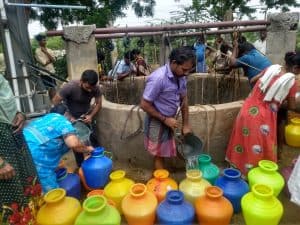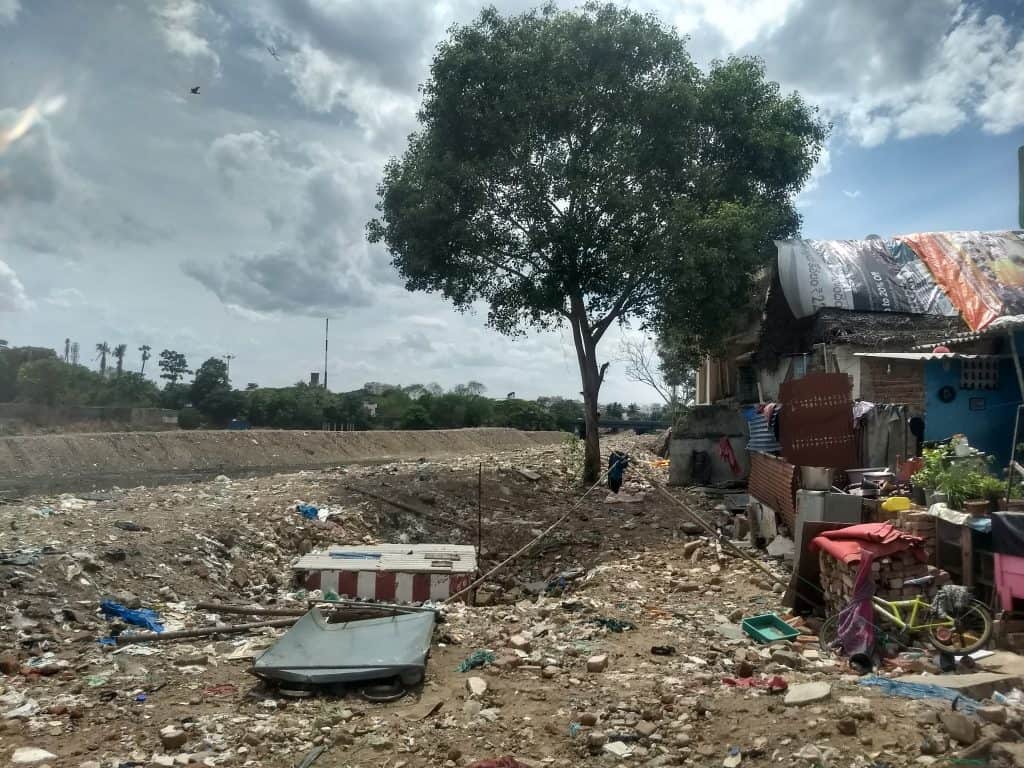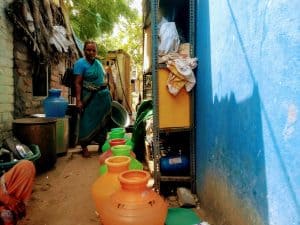It’s a pleasant dawn in early June; however, 52-year-old Zareena is fidgety and keeps checking the time. It’s just 6.30 am. Before long, a teenage boy opens a gate and hordes of people make their way through it to the massive well at Easwari Nagar of Zamin Pallavaram. In a firm voice, Muthu, the caretaker of the well asks people to follow the queue according to their token number. Zareena’s number is sixteen, which means she has to wait for all the fifteen members to get their share of water.
The tokens are distributed on lottery basis every Sunday, and the number you get is yours for a week. “Every family gets three pots of water a day from the well. You have to wait for your number even if you have reached the well first,” explains Zareena. This well has been at the centre of public attention, especially after American actor Leonardo DiCaprio shared the pic on Instagram, alluding to the situation of severe water shortage in the city.
The century-old well is opened thrice a day to quench the thirst of 200-odd families in Easwari Nagar, based on the token system. The higher the number on your token, the later your turn, so that the last token holders will have to wait till the well is opened in the evening. It may not be much, but every family gets water every day. Once. No hassles, no street fights. The responsibility of fair distribution of water is shared by three caretakers.
“Three pots for a family is not enough. We source polluted, yellow coloured water from the quarries for our requirement. But this token system has ensured that there is at least no bias in distribution,” says Zareena.

People draw water from the well at Zamin Pallavaram. The well received global attention when American actor Leonardo DiCaprio shared the pic on Instagram.
15 pots a week
K S Thilagavathy, a resident of Kallukuttai slum, hopes that showers will soon bring relief to the city. Thilagavathy has not taken a bath for two days. “There is no water to shower. How can I do abhishekham for the deity?” worries Thilagavathy, who is a priest at the neighbourhood Vinayagar temple.
Ponds and puddles in the Kallukuttai area have dried up, exposing cracks in the bed. Metro Water is the only source for residents here. Like in many other slums, water distribution has been streamlined at Kallukuttai: Chennai Metro Water Supply and Sewerage Board (CMWSSB) fills the big Sintex tanks and a community head ensures that every house gets 15 pots of water per week. Fifteen pots, irrespective of the number of people in the house.
“Every locality has a head who distributes water among citizens twice a day — morning and evening. Every day forty families get five buckets of water each. These families get their turn only after two days or sometimes, three. This is to avoid conflict among the citizens for water,” said Thilagavathy, also a community head.
But how are people managing with just 15 pots of water for the whole week? The desperation is written clearly on citizens’ faces who would go any length to find water. Some use water very cautiously while a few dig up the puddles and use the saltwater when in dire need. Only a few can afford to buy water from the private tankers.

The slum dwellers of Appaswamy Street were pinning their hopes on the rain bearing clouds. But as usual, the forecast proved to be a damp squib.
Wait for water affects regular lives
At Sathyavani Muthu Nagar (near Central) and Appaswamy Street (at Chetpet), people take turns to wait for water. Many men and women here work as domestic maids, electricians and manual scavengers, so that the task of waiting for water is often left to the elderly. “I call up the locals whenever the tanker arrives. Those who work in the vicinity come to procure water. For others, it is a wait for another day,” says J Gnanaprakasam.

Life becomes topsy turvy if the tankers don’t come on time. Stacking up the empty pots, this resident of Appaswamy Street is eagerly waiting for a tanker.
Eyes darting across the streets, scouting for vehicles, Nagamma, a resident of Sathyavani Muthu Nagar cannot focus on the spinach rice she eats. The woman is eating her lunch only at 4.30 pm, after a long, futile wait for the tanker. “I wanted to be alert when the tanker comes. It is distributed on first-come-first-served basis here. We have to barge in amidst the crowds to actually get water from the tankers,” says Nagamma. As there is not even a drop of water at home and the tanker has not arrived, she works on the hand pump to try her luck, but again in vain.
Water, the deal-breaker
In the lower-income settlements of Chetpet, Ayanavaram and Nungambakkam, however, water distribution is not as streamlined. Chaos breaks out in these localities whenever a water tanker reaches.
“Water has ruined relationships. Close friends turned enemies because of water,” says Gowri, a resident of Somasundaram 5th street, Ayanavaram. It was easy to see what Gowri meant when a water tanker reached the locality at 4 pm on June 7th. People — women, children and old — reached the tanker thick and fast and in no time, and confusion reigned supreme. Every family at this locality is allowed up to five pots of water a day.
Tanks vs tankers
Across all these low-income localities, it appears that the Sintex tanks have been a saviour. In many slums, these tanks were always present, but the residents did not really need them. Most of them got water either through hand pumps or piped water supply. In slums like Sathya Nagar, the number of these tanks has been increased now, due to the situation caused by the drought. But concerns remain.
“Despite having Metro water connections, many slum dwellers do not get water. So it is the duty of the Chennai Metro water department to ensure fair distribution of water at least through these Sintex tanks. Most of the tanks require thorough cleaning, but at a time when piped water is a dream, it is perhaps only a luxury to talk about hygiene issues. The uncertainty of water tankers has forced many college students to bunk classes and women to quit their jobs,” said A D Nandini, a social researcher.
Meanwhile, a spokesperson of CMWSSB said that work is on to increase the number of such tanks (Sintex) in the city. “Water tankers are supposed to go to the localities at a stipulated time. But when there is an agitation in other localities for water, we divert it there to alleviate the situation,” the spokesperson said.
[All photos taken by the author]

Laasya,
You article mentions June twice, but publishing date has been mentioned as July 11th.
BTW, when was this article written? 🙂
Thanks for pointing that out, and apologies – it should be July in both places.